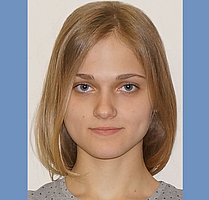Living far from my family makes me look forward to every meeting with them. And here I am, just arrived at the airport, everyone is looking at me, smiling and asking lots of questions, including a dreading one: “Ok, tell us what your work is about?” For me, as a theoretical chemist, this is a mission impossible! Should I bore them with equations and certain words, such as quantum mechanics, level of theory, potential energy surface? It’s hard to be general while speaking about such a specific topic, but I shall give it a try.
In one of my PhD projects I investigate the working cycle of an enzyme called MMP-2 (Matrix Metalloproteinase type 2), finding out the important role of an acidic residue of the enzyme and of the surrounding water.
MMP-2 is located in tissues of animals and humans. It regulates the proper protein composition of the extracellular matrix by cutting collagens (structural proteins of the tissues). At certain conditions MMP-2 may get too active doing its job, it will cut gelatin too fast and too intensely, causing inflammation processes, tumors, metastasis and similar illnesses.
A long-range aim is to find a way to control the activity of MMP-2, for example by designing a molecule (a drug), that would block the active site of the enzyme and stop the excessive degrading of gelatin. But before doing so we need to know in detail how the enzyme works: where the active site of the enzyme is and what rearrangements occur during the chemical reaction. Unfortunately, the experimental techniques cannot give exhaustive information on all the chemical steps, this is where theoretical chemistry comes into play.
The theoretical models we construct are based on experimental data, but we must always keep in mind the approximations we make and the limitations of the theory we use. Nevertheless, our models let us see atoms in molecules, atom movements during chemical reactions, and we can also estimate energy penalties for chemical processes.
Enzymes are big molecules, therefore they are treated by a special “divide and conquer” computational approach, called QM/MM (quantum mechanics/molecular mechanics). Our MMP-2 model system was divided into two parts: a small part, where a chemical reaction takes place, was treated by accurate but computationally expensive (quantum mechanics) methods; the rest (the environment) was treated by fast “balls on springs” approximation, called molecular mechanics. By using this trick we managed to perform accurate calculations on big biomolecules in a reasonable computing time.
The video shows the four main steps of a chemical reaction in MMP-2: 1. a water molecule attacks the substrate (ES — TS1 — I1)1, 2. O-H group rotates (I1 —TS2 — I2), 3. a proton is transferred from an oxygen atom to nitrogen (I2 — TS3 — I3), 4. a bond between carbon and nitrogen breaks (I3 — TS4 — I4). We see that the acidic residue (which is a glutamic acid) plays a crucial role in the chemical reaction and that water molecules act as a reagent. By not letting water into the active site or by changing a substrate in a way that at least one step of a chemical reaction cannot proceed we can stop MMP-2 from working.
I have also modelled a product release step and found out that it may very likely be a rate limiting step of the whole process. In a similar fashion, I’ve studied a mutant of MMP-2 as well.
At the end I’d like to say that a valuable scientific discovery can be made only with the combination of theory, experiment and something as simple as a groundbreaking idea.
————————————————————————————————————————————
1The abbreviations stand for ES: enzyme substrate complex, TS: transition state and I: intermediate.
About the author


